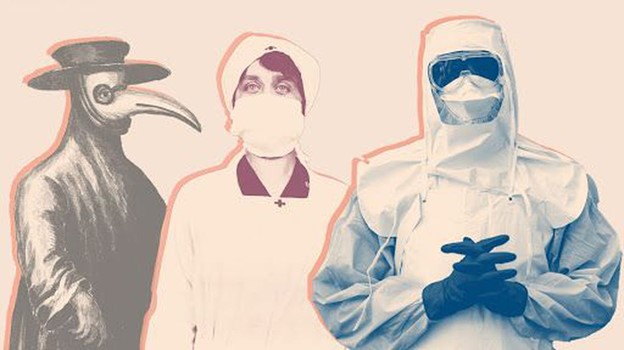The World Health Organization recently declared Covid-19 epidemic as a „pandemic”. Some of the pandemics that have caused millions of deaths worldwide include smallpox, measles, Spanish flu or black plague, according to businessinsider.es, which reviews them according to the number of deaths worldwide.
10. Influenza A virus subtype H1N1 (A/H1N1) – 150,000–575,000 deaths
This pandemic was caused by a variation of Influenzavirus A (subtype H1N1) and the last crisis occurred 11 years ago in 2009, although there had been other influenza A pandemics in previous periods.
The newly discovered influenza A (H1N1) virus is a new subtype of influenza virus that is transmitted to humans and contains genes from swine, avian and human influenza viruses, in a combination that had not been observed until that year nowhere in the world. The symptoms of the new influenza A (H1N1) in humans are generally similar to the symptoms of seasonal human influenza: fever, respiratory symptoms, such as coughing and runny nose, sore throat.
Other symptoms may occur, such as generalized pain (especially muscle pain), headache, chills, fatigue, vomiting or diarrhea (which are not characteristic of the flu but have been reported in some recent cases of influenza with the new virus). In some cases, serious complications can occur even in healthy people infected with the new virus.
In June 2009, WHO classified the disease as alert level 6 (ongoing pandemic), meaning the occurrence of community outbreaks (locally occurring without the presence of an infected person coming from an initial outbreak region).
One year later, on August 10, 2010, WHO announced the end of the pandemic. In 14 months, the virus made its way around the world, infecting between 11% and 21% of the population, although the mortality rate was lower than other diseases, considering that it resulted in between 150,000 and 575,000 victims.
9. Russian flu — 1 million deaths
The Russian flu (1889–1890) was a pandemic that lasted 14 months (between October 1889 and December 1890), but there were still cases after these years.
During the period, this flu with a relatively low mortality rate (1%) caused the death of one million people worldwide and is thought to have been caused by the Influenzavirus A virus subtype H2N2, although it is not known exactly, considering the limits of the virological studies of that time. The pandemic spread rapidly to St. Petersburg in December 1889, continued in Europe and managed to infect the rest of the world in just 4 months.
Historians argue that the pandemic was facilitated by the emergence of rail systems that facilitated the movement of people at a speed that humanity had not known before.
8. Hong Kong flu – 1 million deaths
The flu in Hong Kong is believed to have originated from China and was caused by a variation of H3N2 influenza that had spread in a short time all over the world.
It was the third influenza pandemic of the 20th century and broke out in 1968 when it caused the death of nearly one million people. The highest number of deaths were among those over 65 years of age and the H3N2 virus continues to circulate worldwide as a stationary influenza A virus.
7. Cholera — 3 million deaths
Cholera is an acute, contagious, infectious intestinal disease caused by a bacterium: the cholera vibrator (Vibrio cholera), which had caused over 3 million deaths over time. Every year, between 21,000 and 143,000 deaths are registered due to cholera.
Cholera is a bacterial disease commonly spread through contaminated water. This causes severe diarrhea and dehydration. Untreated, cholera can be fatal in a few hours, even in people with a strong immune system.
Modern sewage and water treatment have virtually eliminated cholera in industrialized countries, but the disease is still present in Africa, South Asia and Haiti.
The risk of cholera epidemic is highest when poverty, war, or natural disasters force people to live in crowded conditions without proper hygiene. Fortunately, cholera is easy to treat. Death results from severe dehydration, which can be prevented by a simple and inexpensive rehydration solution.
6. Typhus— 4 million deaths
Typhus is an infectious and contagious disease caused by insects such as lice. The European lice typhus, caused by Rickettsia Prowazecki, is transmitted to the human by the bite or through the lees (vector animal) from the rickettsiae. The typhoid incubation may take up to three weeks.
The disease is triggered by chills, muscle aches, violent headaches, and high fever. A red rash spreads all over the body surface. The complications that may occur are of a cardiac, arterial and nervous nature. It usually affects rural or isolated populations because of the main vectors. Although typhoid had killed over 4 million people throughout history, it does not pose a risk to the modern world.
5. HIV – 25 million deaths
Another major epidemic since 1981 was AIDS, which involved stigmatizing part of the population and greatly influencing sexual habits, perceptions and relationships. The disease is caused by the Human Immunodeficiency Virus (HIV).
The human immunodeficiency virus causes a chronic, irreversible infection, with the progressive destruction of the host’s defense mechanisms and the installation after a variable period of time, usually years, of acquired immunodeficiency syndrome (AIDS). Human immunodeficiency virus (HIV) infection was first reported in 1981 in the United States.
The total number of people living with HIV / AIDS was approximately 35.3 million, as of December 2013. The number of newly infected people in HIV in 2012 was 2.3 million, of which 2 million adults and 260,000 children. under the age of 15. To date, AIDS had caused the death of 25 million people and remains a major risk to society. Although it does not heal, there are still treatments to improve the lives of those affected.
4. Black or bubonic plague — 75 million deaths
In the 14th century, around 1384, the black plague ravaged Europe. The Mongols came to the Crimean peninsula and tried to conquer it by throwing plague-infected dead bodies over the walls, triggering an epidemic that swept across the continent, except Iceland.
The black or bubonic plume brought important changes in the economy accompanied by a great setback; mortality was 60 percent, and humanity needed 100 years to recover.
Trade disappeared, cities collapsed, people took refuge in villages, kings died, all social structures were affected. The disease that causes huge pustules is not caused by a virus, but by the bacterium Yersinia pestis, still active in rural populations.
The bacterium is transmitted through vectors such as fleas, although the big ones responsible for spreading the plague were rats infesting medieval cities and it was not a divine punishment as it was believed at the time.
3. Spanish flu — between 50 and 100 million deaths
It is estimated that Spanish influenza had caused between 50 and 100 million victims worldwide in just two years. Between 1918 and 1920 the flu killed between 3% and 6% of the world’s population.
The so-called “Spanish flu” of 1918 also caused as many deaths as the First World War, and some experts say that this world conflict ended because of the epidemic. But the epidemic did not occur in Spain.
Spain, which was not part of the conflict, informed most about the flu cases, which received the name from this country. During that period of war and epidemic, economic activity collapsed and greatly boosted the migratory movements.
2. Measles – 200 million deaths
Measles is a disease that is characterized by small red spots on the skin, high fever and a condition of illness, like rubella or chickenpox. The virus stays in the incubation state for 21 days, although the first symptoms appear 10 days after infection.
Throughout history, measles had caused the death of 200 million people as a result of lung inflammation or meningitis. The advances in science have led to the development of the triple antiviral vaccine (SPR), made in children since there is no specific treatment, but the only contagion can be prevented.
- Smallpox — 300 million death
Smallpox, caused by the Variola virus, is one of the diseases that caused the most deaths in human history, over 300 million. For a long time, the survival rate was only 30%, and deaths were caused by high fever, dehydration and other complications.
In addition, the epidemic had disfigured millions of people as it causes pustules that leave permanent traces on the face. It is transmitted through body fluids and direct contact but is considered to have been eradicated since 1980 due to the intense vaccination campaign.
However, two laboratories, the Centers for Disease Control and Prevention (CDC) and the Russian Federation’s Center for Research and Virology and Biotechnology, are reserved for the disease-causing virus.







